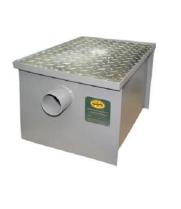Elite Restaurant Equipment / Grease Traps / Getting a Grease Trap Interceptor
Getting a Grease Trap Interceptor
Author: Reid Grant
Grease traps (also known as grease interceptors, grease recovery devices and grease converters) are plumbing devices designed to intercept most greases and solids before they enter a wastewater disposal system. Common wastewater contains small amounts of oils which enter into septic tanks and treatment facilities to form a floating scum layer.
This scum layer is very slowly digested and broken down by microorganisms in the anaerobic digestion process. However, very large amounts of oil from food production in kitchens and restaurants can overwhelm the septic tank or treatment facility, causing a release of untreated sewage into the environment.
Also, high viscosity fats and cooking greases such as lard solidify when cooled, and can combine with other disposed solids to form blockages in drain pipes.
Grease traps have been used since the Victorian days, although Nathaniel Whiting obtained the first patent for a modern day grease trap in the late 1800s. They are used to reduce the amount of fats, oils and greases (FOGs) that enter the main sewers. Effectively they are boxes within the drain run that flows between the sinks in a kitchen to the sewer system.
They only have kitchen waste water flowing through them and are not served by any other drainage system such as toilets. They can be made from a number of different materials; e.g. stainless steel, plastics, concrete & cast iron. They range from 30 gallon capacity to 45,000 gallons and above capacity. They can be located above ground, below ground, inside the kitchen or outside the building. Source
Uses
Restaurant and foodservice kitchens produce a lot of waste grease which is present in the drain lines from the various sinks dishwashers and cooking equipment such as combi ovens and commercial woks. If not removed the grease will congeal within the sewer and cause blockages and back-ups.
In the United States, sewers back up annually “an estimated 400,000 times and municipal sewer overflows on 40,000 occasions”. The EPA has determined that sewer pipe blockages are the leading cause of sewer overflows, and grease is the primary cause of sewer blockages. Even if accumulated FOG does not escalate into blockages and sanitary sewer overflows, it can disrupt wastewater utility operations and increase operations and maintenance requirements.
For these reasons, depending on the country, nearly all municipalities require commercial kitchen operations to fit some kind of interceptor device to collect the grease before it enters the sewer. Additionally where FOG is a concern in the local wastewater collection system communities have set up inspection programs to ensure that these grease traps and/or interceptors are being maintained on a routine basis.
It is estimated 50% of all sanitary sewer overflows are caused by grease blockages with over 10 billion gallons of raw sewage spills annually. Source
How it Works
A traditional grease trap is not a food disposal unit. Unfinished food must be scraped into the garbage or food recycling bin. Milkshakes, gravy, sauces and food solids must be scraped off the dishes before they enter the sink or dishwasher.
To try to maintain some degree of efficiency there has been a trend to specify larger and larger traps. Unfortunately, providing a large tank for the effluent to stand also means that food waste scraps also have time to settle to the bottom of the tank, further reducing the available volume and adding to the clean out problem.
Also, rotting food contained within an interceptor breaks down producing toxic waste (i.e. sulfur gases) - hydrogen sulphide combines with the water present to create sulphuric acid. This attacks mild steel and concrete materials resulting in "rot out". A bigger interceptor is not a better interceptor.
Because it will have been in the trap for some time, grease collected in this way will have been contaminated and is unsuitable for further use. This kind of grease is referred to as brown grease.
Conclusion
Purchasing a Grease Trap / Interceptor for your commercial restaurant or food service business can prove to be a profitable investment. Know how much grease you plan to recover. Speak to your local mechanic to consult on what capacity would best suite your business volume. When purchasing consider purchasing a grease trap that has a larger capacity than you currently need, always leave room for growth!













































